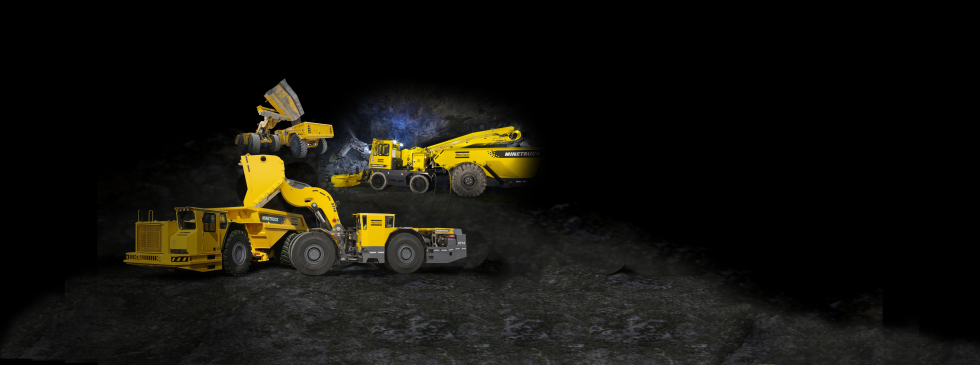Choosing the right method and equipment to match specific conditions for material handling has never been an easy task. Today, the challenge is bigger than ever as mines go deeper and tunnel designs become increasingly complex.
Fortunately, there is plenty of room for increased efficiency and reduced costs. And we do know this: Accurate planning at the earliest possible stage increases your chances of meeting ambitious productivity targets, tight budgets and demands for safety at every step.
Data is being put to use in new ways in the development of engineering solutions, and this certainly applies to mining and tunneling. We now provide an easy way of finding the best options for a wide variety of mucking out operations. The tool we use is called Loading Optimizer. It enables key factors in material handling ? loading methods, equipment and ventilation ? to be finely adjusted. Not only that, they can be simulated to achieve an ideal setup.
Based on our many years of knowledge and accumulated data, Loading Optimizer has been developed to help planners find the most well-matched solution. It eliminates all guesswork from the task of getting blasted material out of excavation areas as quickly and efficiently as possible.
Optimal choices: three methods
By entering key parameters relevant to a specific mining or tunneling project into the tool: length of tunnels, cross-sections, ore production, volumes, densities, swell factors, the size of ventilation ducts and more, we obtain a comprehensive picture of what is needed for any desired rate of loading and haulage.
Equipment specif ications can be imported automatically or manually from the updated Atlas Copco portfolio, or using data from other sources. In the next step, Loading Optimizer gives three suggestions for loading methods that are both feasible and provide high capacity.
When this is done, the tool can be used in a variety of ways to simulate and recalculate different scenarios. The user can make adjustments and comparisons between the proposed methods, and between variations within these methods.
What is the potential impact of choosing continuous loading instead of LHDs? How will productivity levels differ if loaders with side-dumping buckets are used instead of conventional front-end loaders? What are the costs of using rail-bound haulage instead of wheel-bound trucks?
The answers to these and other important questions are given almost instantaneously and illustrated in detail. By importing every conceivable parameter into Loading Optimizer, including local safety regulations, the tool provides tailored options in an easy way. It demonstrates that a simple change in the choice of equipment ca n have a profound effect on loading capacity and total costs.
Spacing of loading bays
Loading bays, or turning niches, for wheelbound LHDs is a typical aspect of planning where considerable savings can be made. The ideal spacing is also a frequently raised question as there is no hard and fast rule for how niches should be excavated.
This is about to change as Loading Optimizer can calculate the achieved productivity level for a given distance between loading bays. In simulating the setup, it is possible to increase the distance between the niches from, say, 100 m to 150 m, but still maintain the same loading capacity by switching from one method to another.
Reducing the number of loading bays in a tunnel or drift means that less excess rock will need to be excavated in a tunnel or drift. And less rock means reduced total volumes and lower costs.
Ventilation systems: Serpent integration
For small and long tunnels ventilation becomes a difficult issue and this is where Loading Optimizer will play a crucial role. The required size of ventilation ducts for fresh air determines how much space is available for equipment, and vice versa.
These parameters, and the off-set between equipment choice, tunnel size and ventilation ducts, can be finely tuned and adjusted to get the right balance. Small and long tunnels are often the most energy-intensive meaning that there is large potential for cost savings.
For example, if a long tunnel requires 25 m3 of air at the inlet, the power consumption will triple as the tube diameter goes from 1.4 m to 1 m as the air pressure increases. This presents planners with a difficult equation.
Loading Optimizer makes it easy to make the right choices based on comparisons. If all machinery has been selected, leaving no more than 1.2 m of free space for ventilation ducts at the tunnel roof, the tool interface will automatically adapt, displaying only the ducts that actually fit. This is done thanks to synchronization with the software for Atlas Copco Serpent ventilation systems.
A customized setup
The Loading Optimizer tool enables each method, together with matching equipment, to be evaluated relative to the application. This way, it breaks from the conventional practice of simply relying on product specifications and loading capacities for decision-making.
By customizing the setup for loading, a complete overview of costs can also be given. Moreover, the flexibility of the tool enables the summarized results to be displayed in just the right way, with preferred units to match the project.
For example, capacities for loading blasted material from the muckpile can be shown in cubic meter volumes or tonnes. Similarly, all costs including labor can be viewed per hour, per tonne or per cubic meter.
Our experience tells us that using an analytical approach, backed up by the Loading Optimizer tool, can yield significant rewards in achieving more cost-effective loading operations.
Epiroc operated under the trademark “Atlas Copco” prior to January 1, 2018.



Here:
Us: